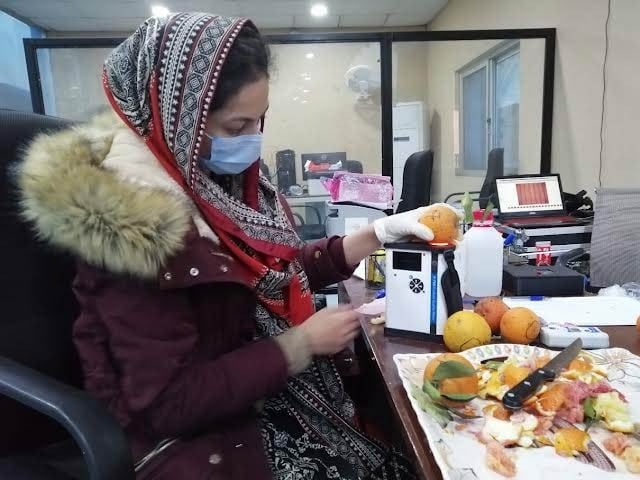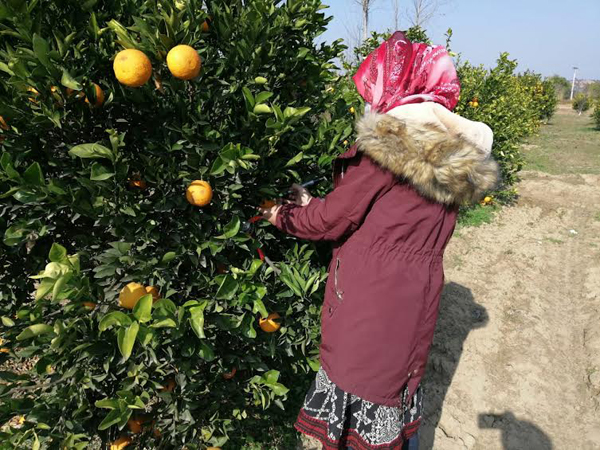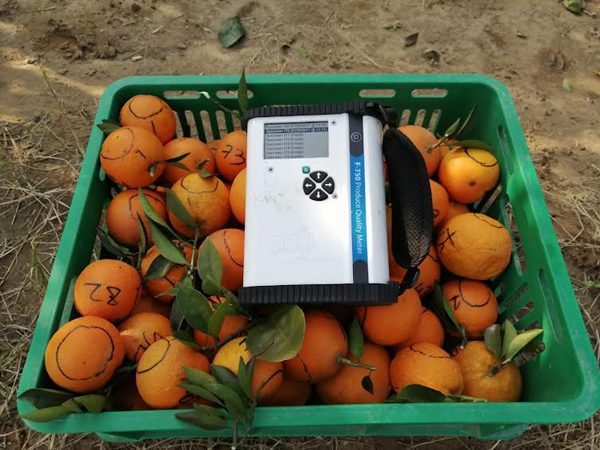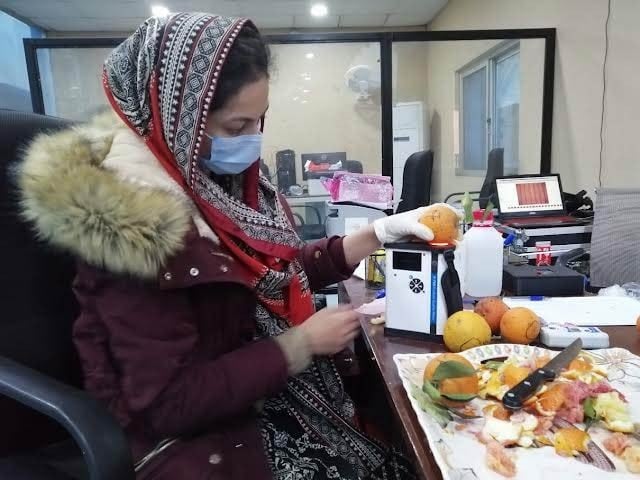
Experts from the National University of Science and Technology have developed a successful AI model to detect the sweetness of local oranges and citrus fruits without opening them. Photo: Courtesy of National University of Science and Technology
Karachi: A team of Pakistani scientists has developed a method to detect the sweetness of citrus fruits such as oranges and kino without opening them using artificial intelligence (AI) and visual properties. This system can predict these sweets with 80% accuracy.
Experts from several universities and institutes under the supervision of Dr. Ayesha Zeib of the National Center for Robotics and Automation of the National University of Science and Technology (NUST) have carried out this important work without harming oranges and related fruits. It can be tasted.
Determination of fruits by infrared light
In the first phase, experts plucked 92 fruits of mosambi, red orange and sweet from a farm in Chakwal district. The average peel of these fruits was 6 mm thick. Circle marks were placed on both sides of each fruit and the spectrum of each fruit was determined from the exact circled area with a manual spectrometer.

A commercially available F750 spectrometer was used for this, which emits near-infrared (near-infrared) light. This light enters the fruit and is reflected back, creating a spectral pattern that is noted. Thus, 64 fruits were used in calibration while 28 fruits were used for prediction and in both of them spectrometer was used as fruit meter.
But first, let’s know what is spectroscopy and what is its importance?
Animate and inanimate objects absorb, emit or reflect light. Spectroscopy, which has become an extremely useful process, is now used to find out the details of an object from this light. But our eyes can see a very small part of the spectrum or radiation called visible light. While angles like X-ray, infrared and ultraviolet etc. are equally important but we cannot see them. Spectroscopy in everyday life not only informs us of a small tumor in the brain, but also tells us about a galaxy millions of light years away.

Although spectroscopy has been used to determine fruit quality for years, Pakistani scientists have used it to determine the sweetness of local oranges. Secondly, this method has succeeded in directly determining sweetness, which is also an important advance.
Conventional chemical and sensory analysis
Scientifically, hundreds of unique chemicals combine to make a fruit flavorful. But generally Brix is a measure of the amount of different types of sugars in a fruit. Be it mango or kino, it is said to be drinkable because of its abundance of sweetness. But on the other hand, the amount of Titratable Acidity (TA) in oranges etc. is used to measure sourness. This measure indicates the amount of citric acid in a fruit.
The scientists first obtained the readings by measuring fruit samples with NIR spectroscopy. Brix, TA and fruit sweetness (via tongue) were then determined by traditional chemical and tasting methods to be used as reference data. This time the fruit was cut from the same marked circles from where the first spectrum was taken. After that, the fruits were cut from the same place and the pulp was extracted and chemically measured in the laboratory. Along with this, human volunteers were made as judges to taste it and rate it as bland, sweet and extra sweet.
AI modeling
“In this way, we first obtained the spectrum of several fruits, then determined the Brix and TA references and labeled the sweetness of each fruit, including the human senses. An AI algorithm (computer software) was then fed data from 128 samples to enable it to correctly predict new input data (which was not part of the training data). On this occasion the AI model came out with excellent results and it correctly estimated the sweetness of the fruit,’ said Dr. Ayesha Zeb while talking to Express.
AI model training
After training the model, experts added data from 48 new fruits to it. It should be noted that this time only spectrum was added so that it could predict Brix, TA and sweetness of all 48 fruits. After estimating the possible sweetness, the experts placed all the fruits included in this ‘test data’ on the laboratory table. They were cut and tested chemically in addition to tasting them. This time too TA, Bricks and Sweetness were in sight. The actual sourness, sweetness, and taste were determined by opening the fruit and comparing it with the results indicated by the AI model.
Express News asked Dr. Ayesha whether lack of light, dust on the fruit or other factors can affect the measurement of the spectrometer or not. So they said, ‘No, because near-infrared (NIR) rays penetrate the fruit very well, from millimeters to centimeters. They pass through the peel to the pulp of the fruit and from there turn around and reach the sensor.’
He said that the particular light creates a particular type of molecular vibration and the instrument tells how much energy has been absorbed. Secondly, the device’s own geometric structure also reduces the reflection process. Thus, the readings are not affected by lack of light or dust on the fruit peel.
An important discovery
After careful estimation, the computer model not only predicted sweetness with a reliable accuracy that was comparable to Brix and TA. But surprisingly, its prediction of overall sweetness was close to 81 percent for sweet, mixed, and acidic or sour flavors, which is also a significant improvement. The demand for such fruits is highest in the citrus industry as sweet juices, beverages, jellies and other products are made from the quality fruit. This is the reason that if this fast-track method is adopted, Pakistani exports can also increase.
Unlike mangoes and bananas, oranges and canos do not ripen further after being cut from the branch, which is why Pakistani innovation can help produce quality fruits. Despite all the difficulties, by the year 2020, the export of Pakistani oranges, cano and mosambi was 460 thousand tons, which can be further increased with the help of technology.
Details of this important development It was published in the weekly scientific journal, ‘Nature’. This is a joint effort of Dr. Ayesha Zeib and Dr. Mohsin Islam of National Center of Robotics and Automation, National University of Sciences and Technology (NUST). Apart from this, Dr. Waqar Shahid Qureshi from School of Computer Science, Technological University Dublin, Ireland, Dr. Abdul Ghafoor, Dr. Muhammad Imran, and Dr. Alina Mirza from Military College of Signals at NUST are also involved. Dr. Amanullah Malik of Faisalabad University of Agriculture, Dr. Isa Al-Anazi of Oram Al-Qura University, Saudi Arabia are also co-assistants in this research.
(function(d, s, id){
var js, fjs = d.getElementsByTagName(s)[0];
if (d.getElementById(id)) {return;}
js = d.createElement(s); js.id = id;
js.src = “//connect.facebook.net/en_US/sdk.js#xfbml=1&version=v2.3&appId=770767426360150”;
fjs.parentNode.insertBefore(js, fjs);
}(document, ‘script’, ‘facebook-jssdk’));
(function(d, s, id) {
var js, fjs = d.getElementsByTagName(s)[0];
if (d.getElementById(id)) return;
js = d.createElement(s); js.id = id;
js.src = “//connect.facebook.net/en_GB/sdk.js#xfbml=1&version=v2.7”;
fjs.parentNode.insertBefore(js, fjs);
}(document, ‘script’, ‘facebook-jssdk’));



